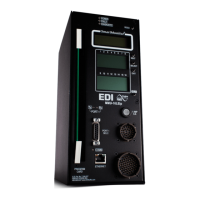MMU2-16LE Series SmartMonitor
®
Malfunction Management Unit
Operations Manual
Eberle Design Inc. Page 4
signal inputs between any two or more channels not assigned to be permissive on the
Program Card. The RED ENABLE input, when activated, enables the Red Fail
Monitoring functions of the unit causing the monitor to trigger when it detects the
absence of voltage on all three (four) of the field signal inputs of a channel. It also
enables the Minimum Yellow Change/Red Clearance Monitoring function which verifies
that the Yellow Change plus Red Clearance interval between the end of an active
Green signal and the beginning of the next conflicting Green signal is proper. The
monitoring circuitry is capable of detecting either full wave or positive and negative
half-wave sinusoidal field signal inputs at the specified voltage levels.
When triggered by the detection of a fault condition which exists longer than the
minimum period defined by the NEMA Standards Publication TS2-2003 (R2008)
v02.06, the MMU2-16LE SmartMonitor
®
will enter the fault mode causing the OUTPUT
relay to de-energize and two sets of contacts on the OUTPUT relay to transfer. The
cabinet assembly should be wired such that the closure of the OUTPUT relay contacts
will cause an automatic switching of the field signal outputs from normal operation to
flashing operation. The MMU2-16LE SmartMonitor
®
will then display the appropriate
fault status. The loss of AC LINE will not reset the fault mode of the OUTPUT relay
contacts. In the event of AC LINE loss the MMU2-16LE SmartMonitor
®
will retain the
status of all fault and channel indicators and will display the correct fault and channel
status upon restoration of AC LINE.
When operating in the Type 16 mode and connected to a TS2 Controller Unit, the
MMU2-16LE SmartMonitor
®
has the ability to exchange information in a standardized
format with the Controller Unit in real time using Port 1. Messages are defined in the
TS2 Standard which allows the Controller Unit and the MMU2-16LE SmartMonitor
®
to
perform redundant checks on each other. The Controller Unit has access to all MMU2-
16LE SmartMonitor
®
information including field signal input status, permissive
programming, and fault status. This gives the Controller Unit the capability to provide a
backup monitoring function and make enhanced event logging, remote intersection
monitoring, and remote diagnostics feasible. Similarly, the MMU2-16LE SmartMonitor
®
receives information from the Controller Unit which corresponds to the Controller Unit
output commands to the load switches. This allows the MMU2-16LE SmartMonitor
®
to
better respond to and diagnose fault situations.
The TS2 Standard also provides for messages to be generated by the Controller Unit
and the MMU2-16LE SmartMonitor
®
which extend the communications capabilities of a
standard assembly. The Eberle Design MMU2-16LE SmartMonitor
®
uses these
message facilities to provide enhanced application specific diagnostic reporting and
monitoring.
1.4 FIELD SIGNAL TERMINALS
A GREEN, YELLOW, or WALK field signal input will be sensed as active by the MMU2-
16E SmartMonitor
®
when it exceeds the Green, Yellow, or Walk Signal Detect voltage
threshold (Section 8.1.2) and a field signal input will be sensed as inactive when it is
less than the Green, Yellow, or Walk Signal No-Detect voltage threshold (Section
8.1.2). Both positive and negative half wave rectified inputs will be sensed.
A RED (DON’T WALK) field signal input will be sensed as active by the MMU2-16E
when it exceeds the Red Signal Detect voltage threshold (Section 8.1.2) and a field
signal input will be sensed as inactive when it is less than the Red Signal No-Detect
voltage threshold (Section 8.1.2). Both positive and negative half wave rectified inputs
will be sensed.
NOTE: When the circuit connected to the sensing input of an MMU exhibits high
impedance characteristics such as caused by dimmers, burned out lamps, low wattage
equipment, or no load, it may be necessary to place a low impedance device external

